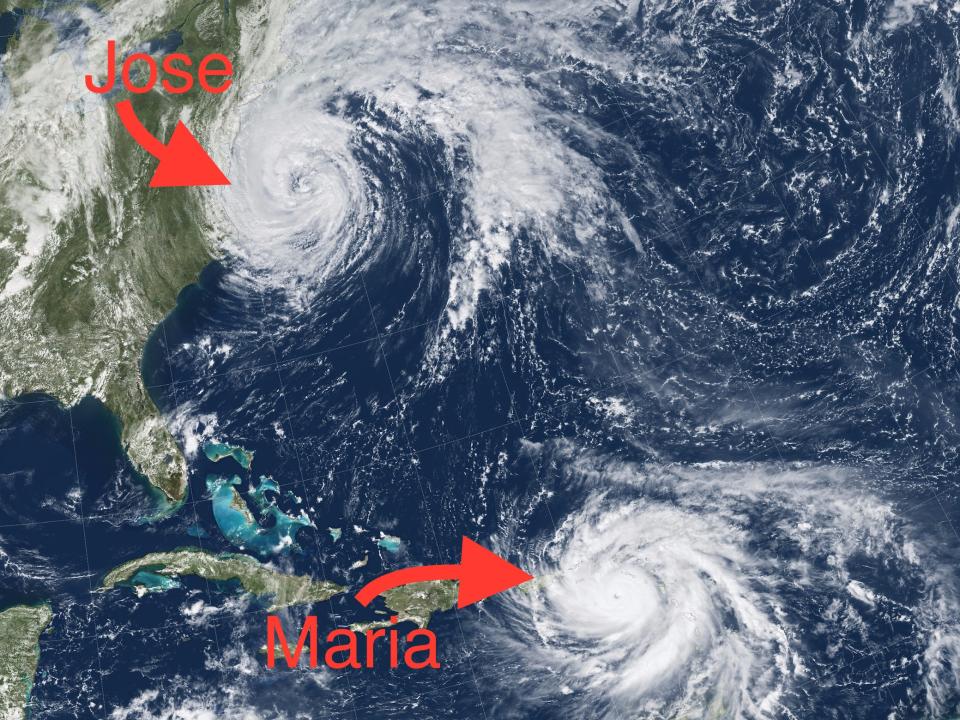Tropical Storm Jose could protect the East Coast from Hurricane Maria

NASA-NOAA GOES
Hurricane Maria's path is similar to the track Hurricane Irma took on its devastating journey through the Caribbean just two weeks ago.
But Maria is unlikely to follow Irma's trail to Florida. And meteorologists say Tropical Storm Jose — which used to be a powerful hurricane — could help keep Maria away from the US East Coast, though it's too soon to say for sure.
Like Irma, Maria has brought intense, destructive forces to the Virgin Islands and Puerto Rico, which took a direct hit from Maria Wednesday morning — making the hurricane the third strongest ever to hit the US.
After slamming Puerto Rico and coming close to the Dominican Republic, Maria will likely turn north and almost certainly avoid Florida, according to most projections.
While it's possible the storm could curve toward the East Coast at some point, there's a good chance that Jose, which is slowly moving along the East Coast, could help keep Maria at sea.
Tweet Embed:
https://twitter.com/mims/statuses/910196331599339522
As we await new model guidance for Hurricane #Maria ... ECMWF ensemble spaghetti tracks from 00z all show recurvature in 5-days. pic.twitter.com/98Ss85gWqu
Weather.com meteorologist Chris Dolce explained why this is the case. There's currently an area of high pressure moving above the US Midwest and parts of the Northeast. Conditions in such areas are basically the opposite of the ones that form hurricanes, since cyclones are low-pressure systems. Storms and high-pressure systems don't merge or penetrate each other.
There is also a high-pressure area to the east of Maria right now. If the system that's over the US were to move out into the Atlantic, these two systems could form a stretch of high-pressure air that would force Maria toward the US East Coast.
But right now, Jose is blocking the high-pressure area over the US from spreading into the Atlantic. In doing so, it's creating a low-pressure "alley" or trough between the two systems — and giving Maria a path away from the coast. If Jose stays where it is out at sea, that alley will remain there for Maria; but if Jose dissipates, Maria could head coast-ward.
Meteorologist Guy Walton explained how that works on Twitter: "Think of low pressure, or a trough, acting as a vacuum sucking a storm toward it, as with the case with José acting on Maria to the north," he wrote.
Long "ridges" of high-pressure air in the Atlantic tend to become more common in September, according to Reuters, which is why hurricanes are more likely to hit the northeast after hurricane season's peak (which is around September 10).
There's also a chance that Maria and Jose could do something called a "Fujiwhara effect," according to Dolce. That would involve the two systems rotating around each other hundreds of miles apart. In that case, the effect could swing a weakened and much less destructive Jose back towards the mainland, with Maria going out to sea.
Still, these interactions are complicated, and some data indicates a growing likelihood that the Northeast — New York City particularly — could experience hurricane-force winds next week.
But until powerful Maria moves on from Puerto Rico, it'll be hard to say where it'll go next. Weather Channel meteorologist Bryan Norcross wrote on Facebook that the consequences of Maria's small center hitting mountainous terrain in Puerto Rico "injects a bit of uncertainty into the future track."
See Also:

 Yahoo Finance
Yahoo Finance 
